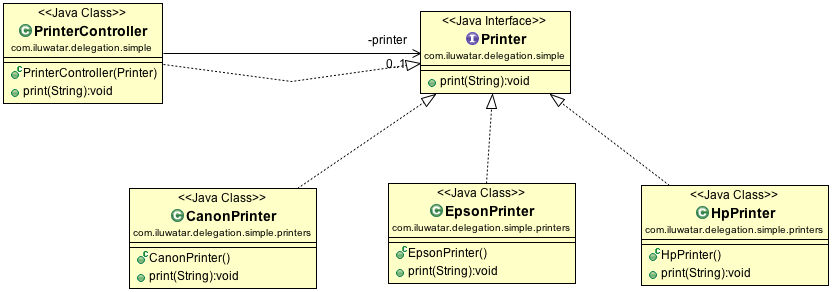Delegation
Also known as
Proxy Pattern
Intent
It is a technique where an object expresses certain behavior to the outside but in reality delegates responsibility for implementing that behaviour to an associated object.
Explanation
Real-world example
Imagine that we have adventurers who fight monsters with different weapons depending on their abilities and skills. We must be able to equip them with different ones without having to modify their source code for each one. The delegation pattern makes it possible by delegating the dynamic work to a specific object implementing an interface with relevant methods.
Wikipedia says
In object-oriented programming, delegation refers to evaluating a member (property or method) of one object (the receiver) in the context of another original object (the sender). Delegation can be done explicitly, by passing the sending object to the receiving object, which can be done in any object-oriented language; or implicitly, by the member lookup rules of the language, which requires language support for the feature.
Programmatic Example
We have an interface Printer and three implementations CanonPrinter, EpsonPrinter and HpPrinter.
public interface Printer {
void print(final String message);
}
@Slf4j
public class CanonPrinter implements Printer {
@Override
public void print(String message) {
LOGGER.info("Canon Printer : {}", message);
}
}
@Slf4j
public class EpsonPrinter implements Printer {
@Override
public void print(String message) {
LOGGER.info("Epson Printer : {}", message);
}
}
@Slf4j
public class HpPrinter implements Printer {
@Override
public void print(String message) {
LOGGER.info("HP Printer : {}", message);
}
}
The PrinterController can be used as a Printer by delegating any work handled by this interface to an object implementing it.
public class PrinterController implements Printer {
private final Printer printer;
public PrinterController(Printer printer) {
this.printer = printer;
}
@Override
public void print(String message) {
printer.print(message);
}
}
Now on the client code printer controllers can print messages differently depending on the object they're delegating that work to.
private static final String MESSAGE_TO_PRINT = "hello world";
var hpPrinterController = new PrinterController(new HpPrinter());
var canonPrinterController = new PrinterController(new CanonPrinter());
var epsonPrinterController = new PrinterController(new EpsonPrinter());
hpPrinterController.print(MESSAGE_TO_PRINT);
canonPrinterController.print(MESSAGE_TO_PRINT);
epsonPrinterController.print(MESSAGE_TO_PRINT)
Program output:
HP Printer : hello world
Canon Printer : hello world
Epson Printer : hello world
Class diagram

Applicability
Use the Delegate pattern in order to achieve the following
- Reduce the coupling of methods to their class
- Components that behave identically, but realize that this situation can change in the future.